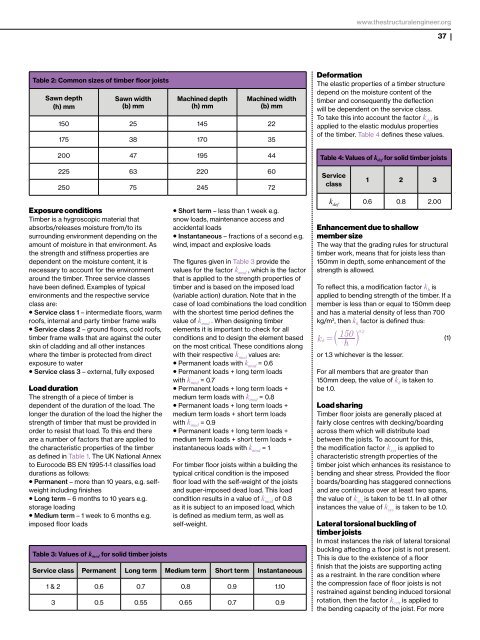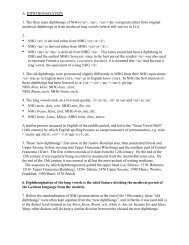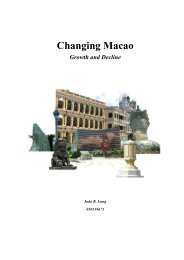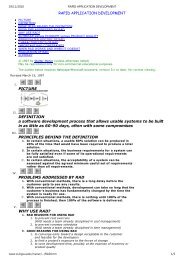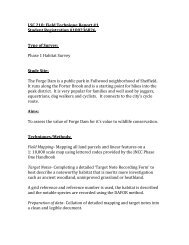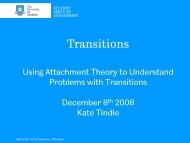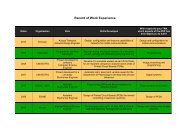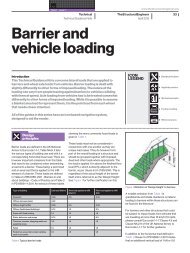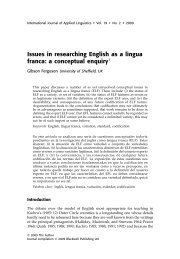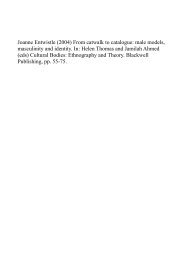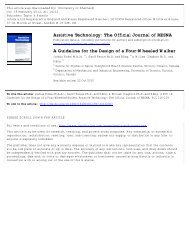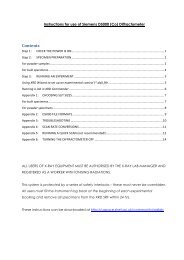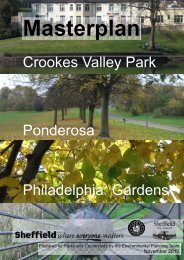19 - Design of Timber Floor Joists.pdf
19 - Design of Timber Floor Joists.pdf
19 - Design of Timber Floor Joists.pdf
You also want an ePaper? Increase the reach of your titles
YUMPU automatically turns print PDFs into web optimized ePapers that Google loves.
Table 2: Common sizes <strong>of</strong> timber floor joists<br />
Sawn depth<br />
(h) mm<br />
Sawn width<br />
(b) mm<br />
Exposure conditions<br />
<strong>Timber</strong> is a hygroscopic material that<br />
absorbs/releases moisture from/to its<br />
surrounding environment depending on the<br />
amount <strong>of</strong> moisture in that environment. As<br />
the strength and stiffness properties are<br />
dependent on the moisture content, it is<br />
necessary to account for the environment<br />
around the timber. Three service classes<br />
have been defined. Examples <strong>of</strong> typical<br />
environments and the respective service<br />
class are:<br />
• Service class 1 – intermediate floors, warm<br />
ro<strong>of</strong>s, internal and party timber frame walls<br />
• Service class 2 – ground floors, cold ro<strong>of</strong>s,<br />
timber frame walls that are against the outer<br />
skin <strong>of</strong> cladding and all other instances<br />
where the timber is protected from direct<br />
exposure to water<br />
• Service class 3 – external, fully exposed<br />
Load duration<br />
The strength <strong>of</strong> a piece <strong>of</strong> timber is<br />
dependent <strong>of</strong> the duration <strong>of</strong> the load. The<br />
longer the duration <strong>of</strong> the load the higher the<br />
strength <strong>of</strong> timber that must be provided in<br />
order to resist that load. To this end there<br />
are a number <strong>of</strong> factors that are applied to<br />
the characteristic properties <strong>of</strong> the timber<br />
as defined in Table 1. The UK National Annex<br />
to Eurocode BS EN <strong>19</strong>95-1-1 classifies load<br />
durations as follows:<br />
• Permanent – more than 10 years, e.g. selfweight<br />
including finishes<br />
• Long term – 6 months to 10 years e.g.<br />
storage loading<br />
• Medium term – 1 week to 6 months e.g.<br />
imposed floor loads<br />
Machined depth<br />
(h) mm<br />
Machined width<br />
(b) mm<br />
150 25 145 22<br />
175 38 170 35<br />
200 47 <strong>19</strong>5 44<br />
225 63 220 60<br />
250 75 245 72<br />
Table 3: Values <strong>of</strong> k mod for solid timber joists<br />
• Short term – less than 1 week e.g.<br />
snow loads, maintenance access and<br />
accidental loads<br />
• Instantaneous – fractions <strong>of</strong> a second e.g.<br />
wind, impact and explosive loads<br />
The figures given in Table 3 provide the<br />
values for the factor k mod , which is the factor<br />
that is applied to the strength properties <strong>of</strong><br />
timber and is based on the imposed load<br />
(variable action) duration. Note that in the<br />
case <strong>of</strong> load combinations the load condition<br />
with the shortest time period defines the<br />
value <strong>of</strong> k mod . When designing timber<br />
elements it is important to check for all<br />
conditions and to design the element based<br />
on the most critical. These conditions along<br />
with their respective k mod values are:<br />
• Permanent loads with k mod = 0.6<br />
• Permanent loads + long term loads<br />
with k mod = 0.7<br />
• Permanent loads + long term loads +<br />
medium term loads with k mod = 0.8<br />
• Permanent loads + long term loads +<br />
medium term loads + short term loads<br />
with k mod = 0.9<br />
• Permanent loads + long term loads +<br />
medium term loads + short term loads +<br />
instantaneous loads with k mod = 1<br />
For timber floor joists within a building the<br />
typical critical condition is the imposed<br />
floor load with the self-weight <strong>of</strong> the joists<br />
and super-imposed dead load. This load<br />
condition results in a value <strong>of</strong> k mod <strong>of</strong> 0.8<br />
as it is subject to an imposed load, which<br />
is defined as medium term, as well as<br />
self-weight.<br />
Service class Permanent Long term Medium term Short term Instantaneous<br />
1 & 2 0.6 0.7 0.8 0.9 1.10<br />
3 0.5 0.55 0.65 0.7 0.9<br />
www.thestructuralengineer.org<br />
37<br />
Deformation<br />
The elastic properties <strong>of</strong> a timber structure<br />
depend on the moisture content <strong>of</strong> the<br />
timber and consequently the deflection<br />
will be dependent on the service class.<br />
To take this into account the factor k def is<br />
applied to the elastic modulus properties<br />
<strong>of</strong> the timber. Table 4 defines these values.<br />
Table 4: Values <strong>of</strong> k def for solid timber joists<br />
Service<br />
class<br />
Enhancement due to shallow<br />
member size<br />
The way that the grading rules for structural<br />
timber work, means that for joists less than<br />
150mm in depth, some enhancement <strong>of</strong> the<br />
strength is allowed.<br />
To reflect this, a modification factor k h is<br />
applied to bending strength <strong>of</strong> the timber. If a<br />
member is less than or equal to 150mm deep<br />
and has a material density <strong>of</strong> less than 700<br />
kg/m 3 , then k h factor is defined thus:<br />
150 . 02<br />
kh<br />
= a k<br />
h<br />
1 2 3<br />
k def 0.6 0.8 2.00<br />
or 1.3 whichever is the lesser.<br />
For all members that are greater than<br />
150mm deep, the value <strong>of</strong> k h is taken to<br />
be 1.0.<br />
(1)<br />
Load sharing<br />
<strong>Timber</strong> floor joists are generally placed at<br />
fairly close centres with decking/boarding<br />
across them which will distribute load<br />
between the joists. To account for this,<br />
the modification factor ksys is applied to<br />
characteristic strength properties <strong>of</strong> the<br />
timber joist which enhances its resistance to<br />
bending and shear stress. Provided the floor<br />
boards/boarding has staggered connections<br />
and are continuous over at least two spans,<br />
the value <strong>of</strong> ksys is taken to be 1.1. In all other<br />
instances the value <strong>of</strong> ksys is taken to be 1.0.<br />
Lateral torsional buckling <strong>of</strong><br />
timber joists<br />
In most instances the risk <strong>of</strong> lateral torsional<br />
buckling affecting a floor joist is not present.<br />
This is due to the existence <strong>of</strong> a floor<br />
finish that the joists are supporting acting<br />
as a restraint. In the rare condition where<br />
the compression face <strong>of</strong> floor joists is not<br />
restrained against bending induced torsional<br />
rotation, then the factor k crit is applied to<br />
the bending capacity <strong>of</strong> the joist. For more


